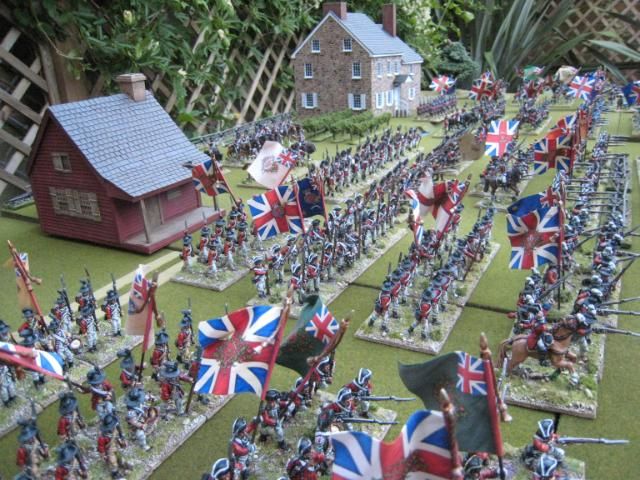

It's been a while coming, but this is the British half of the AWI army parade that I posted back in July 2008 (see here). I realised that if I didn't do it today, I probably wouldn't do it this year, as the conditions were perfect: the hottest day of summer so far; a rather strong bottle of Spanish rose over lunch, which put paid to the hope of any painting this afternoon; and the pleasure of listening to England see off some other upstart colonials in the cricket (with all due respect to my Australian readers - you know that Australia is only behind England and New Zealand in my affections....). So here are the forces of King George, an army that did its best in difficult circumstances and, though it probably didn't realise it at the time, ultimately produced by far the better historical outcome by losing. [Incidentally, I note from a comparison of last year's photos with today's that my gardening skills clearly need improvement.]
First, some general views. i brigades most of the line regiments into brigades of 3-4, but this is not historical. However, all units are "at strength" at 1:20 and based for relevant "British Grenadier!" scenarios


Burgoyne's force: This is minus grenadiers, Brunswickers and specific artillery figures, but you can get a sense of how small the line regiments are in 1:20 (2 foot regiments are only 12 figures). For more on the Burgoyne expedition, please see the Saratoga posts label here.






British artillery, with various orders of dress all massed together:




The Hess-Kassel contingent. This is only about a quarter of the regiments supplied:
 .
. 


Highlanders, Grenadiers and elites:






It's worth pointing out that, even more so than with the American parade, this collection reflects the work of Alan Perry. A few of the indians are by Conquest Minatures, and the Queen's Rangers Highlanders are from Eureka, but everything else is sculpted by Alan, for either Foundry or Perry Miniatures. If Paul Collingwood can get an MBE for a handful of runs in test cricket, then surely.....



































